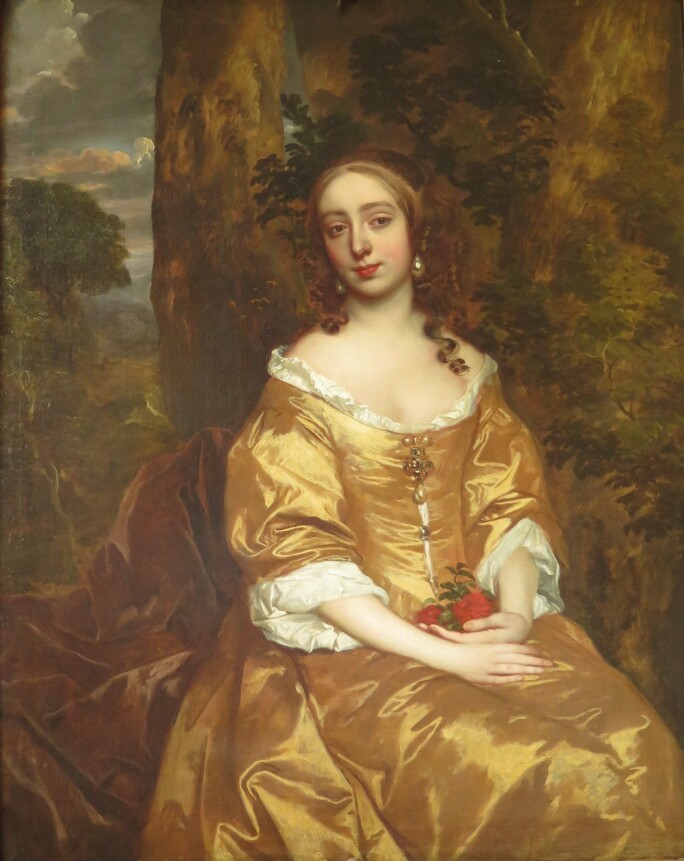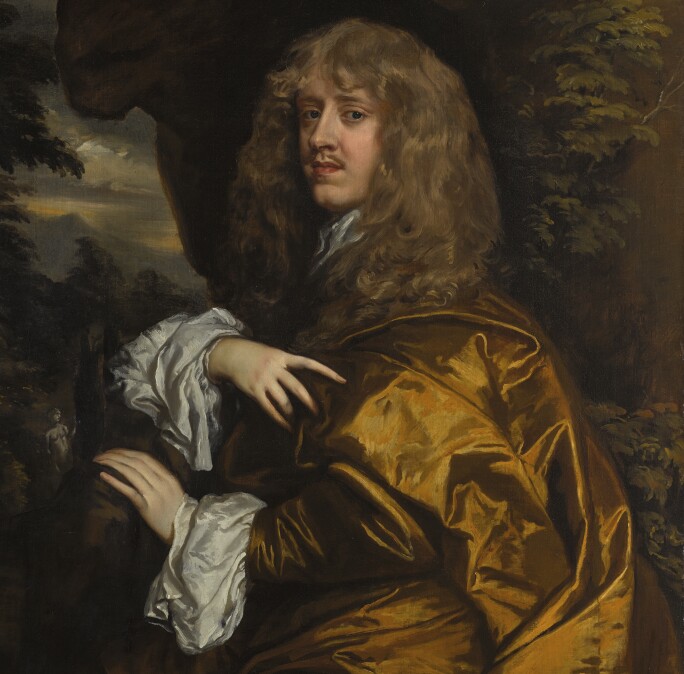This magnificent swagger portrait of the Earl of Chesterfield was painted at the height of Lely’s powers, circa 1660, about the time of the sitter’s marriage to his second wife, Lady Elizabeth Butler (1640–1665), daughter of the Duke of Ormonde, in September of that year. Lely also painted a pendant portrait of Elizabeth, described by contemporaries as ‘one of the most agreeable women in the world’, which remains at the Stanhope family seat, Chevening House, Kent (fig. 1). Both paintings share the same richly painted landscape setting and the two sitters are depicted in matching golden robes, which Miller described as ‘one of [Lely’s] loveliest passages of pure colour, in the high key which characterises many of his portraits in the early Restoration period’.1

Chesterfield was the son of Sir Henry Stanhope and his wife, Katherine Wootton, who was governess to Princess Mary, the Princess Royal (and later Princess of Orange). His father died when he was an infant and Chesterfield was raised by his mother in the Netherlands, before travelling widely in Europe as a young man. In 1652 he returned to England and married his first wife, Lady Anne Percy, daughter of the 10th Earl of Northumberland, though she died of smallpox after only two years of marriage, followed shortly by their infant son. In his bereavement Stanhope returned to the continent, first to Paris and then Rome, only returning to England following the death of his grandfather in September 1656, whom he succeeded as 2nd Earl. A noted ladies’ man, prone to duelling (for which he was arrested on several occasions in the 1650s), his numerous mistresses included Barbara Villiers (later Duchess of Cleveland and principal mistress to King Charles II), with whom he conducted a passionate affair before the Restoration, and Lady Elizabeth Howard, who later married John Dryden.

In September 1659 he was accused of complicity in Sir George Booth’s Royalist uprising, for which he was imprisoned in the Tower, and in January 1660 he was forced to flee the country having killed the son of a Hammersmith doctor in a duel over the price of a mare. He subsequently sought the pardon of Charles II at Breda and was able to join the King on his triumphant journey to England at the Restoration. Following his second wife’s death in 1665, he married, thirdly, Lady Elizabeth Dormer (1653–1677), daughter and co-heir of Charles Dormer, 2nd Earl of Carnarvon and his wife Elizabeth Capel (see lot 27).
By his third wife Chesterfield had two sons and two daughters, the eldest of whom married the Rt Hon. Thomas Coke, Vice-Chamberlain to Queen Anne and a member of the Privy Council. Coke was one of the original backers of the Royal Academy of Music, establishing the first London opera company which commissioned numerous works from Handel, Bononcini and others; as well as a gentleman architect in the golden age of English amateur architecture. It was he who laid out the formal gardens at Melbourne between 1696 and 1706, with assistance from Henry Wise, which still survive today. Melbourne and its contents have passed through family descent ever since and over the years the house has been host to significant political, literary and military events. It is probably most famous, however, as the home of Queen Victoria’s trusted Prime Minister, William Lamb, 2nd Viscount Melbourne, and his wife, Lady Caroline Lamb, famously the lover of Lord Byron.
Lely, or his studio, appears to have re-used this composition in a portrait of a ‘Mr. Stafford’ at Kingston Lacy, Dorset (National Trust).
1 Millar in London 1978, p. 55.

